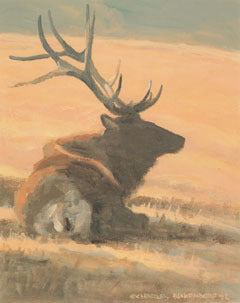
V-14 Elk
Color Reproduction | By Charles Beckendorf
Additional Information
The indigenous elk of the Trans Pecos was the Merriams subspecies and was totally hunted out by the 1880's. Elk were reintroduced into the Guadalupe Mountains of Texas in 1929. These elk came from a refuge in South Dakota and were released at the mouth of McKittrick Canyon, but they went just about everywhere except McKittrick Canyon. They have spread out over the surrounding areas, survived and multiplied. Several hundred elk now roam free in and around the Guadalupes.
This image is from the Charles Beckendorf Texas Wildlife book. The original was an acrylic painting on canvas (1992) and the size is approximately 7.5" x 9.5" inches. The total edition size of this print is 500
Color Reproduction
The indigenous elk of the Trans Pecos was the Merriams subspecies and was totally hunted out by the 1880's. Elk were reintroduced into the Guadalupe Mountains of Texas in 1929. These elk came from a refuge in South Dakota and were released at the mouth of McKittrick Canyon, but they went just about everywhere except McKittrick Canyon. They have spread out over the surrounding areas, survived and multiplied. Several hundred elk now roam free in and around the Guadalupes.
This image is from the Charles Beckendorf Texas Wildlife book. The original was an acrylic painting on canvas (1992) and the size is approximately 7.5" x 9.5" inches. The total edition size of this print is 500
Beckendorf color reproductions are developed using four color process printing on fine white paper. This advanced technique utilizes separate color plates for each of the primary colors, plus black. High-resolution digital scans and special process inks are utilized to yield beautiful, accurate reproductions.
About the Artist - Charles Beckendorf
Charles grew up in Mathis, Texas, where he had the opportunity to spend hours on large ranches. Generous land owners gave him permission to wander freely over their ranches and he observed creatures in their natural surroundings. He developed a lifelong love of nature, whether it be in the tiniest of flowers or the largest of animals. It was at this time that he became a true naturalist.
We Also Recommend
REVIEWS





